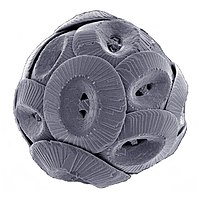
Photo from wikipedia
Abstract Correspondence between evolution and development has been discussed for more than two centuries. Recent work reveals that phylogeny−ontogeny correlations are indeed present in developmental transcriptomes of eukaryotic clades with… Click to show full abstract
Abstract Correspondence between evolution and development has been discussed for more than two centuries. Recent work reveals that phylogeny−ontogeny correlations are indeed present in developmental transcriptomes of eukaryotic clades with complex multicellularity. Nevertheless, it has been largely ignored that the pervasive presence of phylogeny−ontogeny correlations is a hallmark of development in eukaryotes. This perspective opens a possibility to look for similar parallelisms in biological settings where developmental logic and multicellular complexity are more obscure. For instance, it has been increasingly recognized that multicellular behavior underlies biofilm formation in bacteria. However, it remains unclear whether bacterial biofilm growth shares some basic principles with development in complex eukaryotes. Here we show that the ontogeny of growing Bacillus subtilis biofilms recapitulates phylogeny at the expression level. Using time-resolved transcriptome and proteome profiles, we found that biofilm ontogeny correlates with the evolutionary measures, in a way that evolutionary younger and more diverged genes were increasingly expressed toward later timepoints of biofilm growth. Molecular and morphological signatures also revealed that biofilm growth is highly regulated and organized into discrete ontogenetic stages, analogous to those of eukaryotic embryos. Together, this suggests that biofilm formation in Bacillus is a bona fide developmental process comparable to organismal development in animals, plants, and fungi. Given that most cells on Earth reside in the form of biofilms and that biofilms represent the oldest known fossils, we anticipate that the widely adopted vision of the first life as a single-cell and free-living organism needs rethinking.
Journal Title: Molecular Biology and Evolution
Year Published: 2020
Link to full text (if available)
Share on Social Media: Sign Up to like & get
recommendations!